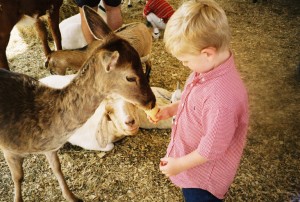It’s fair season across the south. Lots of excitement is building for rides, agriculture competitions and the deep fried food of the moment (this year it is apparently Girl Scout cookies). I spent today at the North Carolina State Fair judging home food preserves with a bunch of great folks. More on that later.
When I arrived at the fairgrounds I drove past the Kelley Building, ground zero for an E. coli O157:H7 outbreak in 2011 linked to 25 illnesses. The building wasn’t considered to be an animal contact area – a petting zoo – but was a spot that was a popular cut-through from an entrance gate to the midway area. Organizers of the fair led a commission to look at what happened, and made changes – having more handwashing stations, reminders and people reminding; further limiting access to non-petting zoo animal buildings; and, increasing cleaning and sanitation. 
A couple of years ago Gonzalo Erdozian esteemed member of the barfblog team, looked at what was available at a bunch of small petting zoo sites/events in Kansas and Missouri – and came up with some great suggestions after finding lots of risky practices (abstract is below). Reducing risks at fairs and petting zoos isn’t a simple thing – it’s a mix of having the tools, people to point patrons to them, and explaining the risks (without being jerks).
While there isn’t a whole lot of info available, a Gaston County, NC family says that their 12-year-old son is hospitalized with E. coli-linked illness and it may be tied to the Cleveland County Fair (and possibly three other cases as well).
According to WSOTV,
While doctors haven’t confirmed where he got it from, his parents said it was from the Cleveland County Fair.
The parents told Eyewitness News they went to the fair last Sunday. They didn’t want us to release their child’s name but said he ate two corn dogs, and went to the petting zoo. At first, the parents thought their son had a stomach virus but then noticed his symptoms got worse as the week went on. On Friday, they took him to his pediatrician and that same day, he was admitted to Levine Children’s Hospital in Charlotte.
His father said doctors told him what made his son sick was not the livestock at the fair (I wonder what info led to that? Maybe onset of symptoms? -ben).
The state is now launching an investigation into three other cases in our area. They’re looking at what the patients have in common — what they ate, where they ate it and if they have been in contact with animals.
A table of petting zoo outbreaks is available at http://bites.ksu.edu/petting-zoos-outbreaks.
—
Erdozain G, Kukanich K, Chapman B, Powell D. 2012. Observation of public health risk behaviours, risk communication and hand hygiene at Kansas and Missouri petting zoos – 2010-2011. Zoonoses Public Health. 2012 Jul 30. doi: 10.1111/j.1863-2378.2012.01531.x. [Epub ahead of print]
Outbreaks of human illness have been linked to visiting settings with animal contact throughout developed countries. This paper details an observational study of hand hygiene tool availability and recommendations; frequency of risky behavior; and, handwashing attempts by visitors in Kansas (9) and Missouri (4), U.S., petting zoos. Handwashing signs and hand hygiene stations were available at the exit of animal-contact areas in 10/13 and 8/13 petting zoos respectively. Risky behaviors were observed being performed at all petting zoos by at least one visitor. Frequently observed behaviors were: children (10/13 petting zoos) and adults (9/13 petting zoos) touching hands to face within animal-contact areas; animals licking children’s and adults’ hands (7/13 and 4/13 petting zoos, respectively); and children and adults drinking within animal-contact areas (5/13 petting zoos each). Of 574 visitors observed for hand hygiene when exiting animal-contact areas, 37% (n=214) of individuals attempted some type of hand hygiene, with male adults, female adults, and children attempting at similar rates (32%, 40%, and 37% respectively). Visitors were 4.8x more likely to wash their hands when a staff member was present within or at the exit to the animal-contact area (136/231, 59%) than when no staff member was present (78/343, 23%; p<0.001, OR=4.863, 95% C.I.=3.380-6.998). Visitors at zoos with a fence as a partial barrier to human-animal contact were 2.3x more likely to wash their hands (188/460, 40.9%) than visitors allowed to enter the animals’ yard for contact (26/114, 22.8%; p<0.001, OR= 2.339, 95% CI= 1.454-3.763). Inconsistencies existed in tool availability, signage, and supervision of animal-contact. Risk communication was poor, with few petting zoos outlining risks associated with animal-contact, or providing recommendations for precautions to be taken to reduce these risks.
